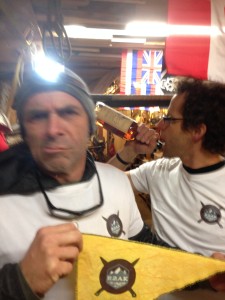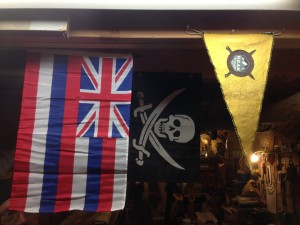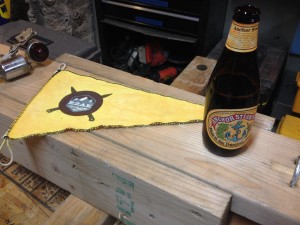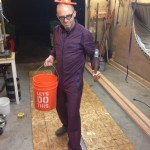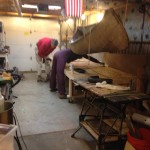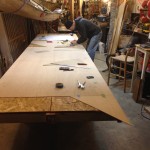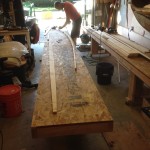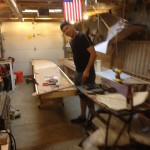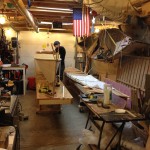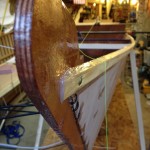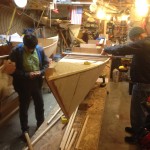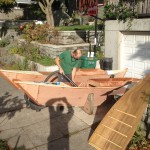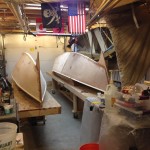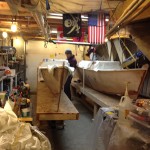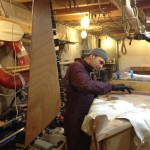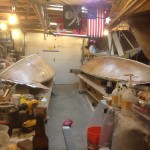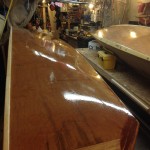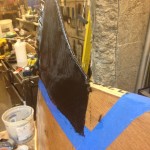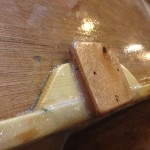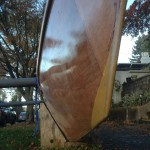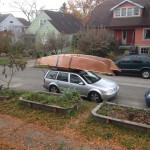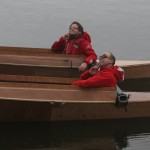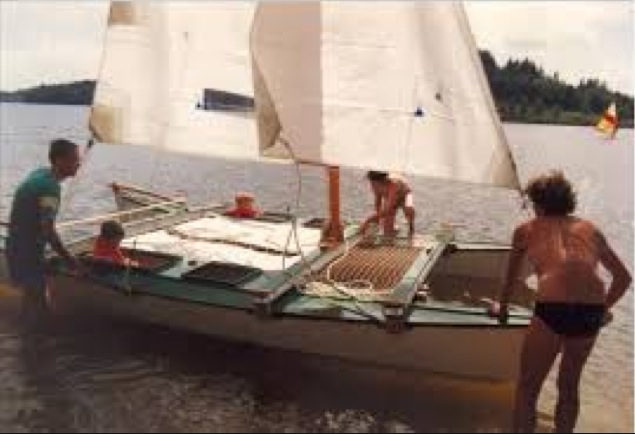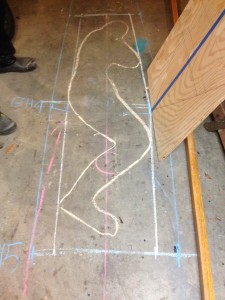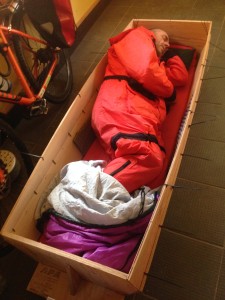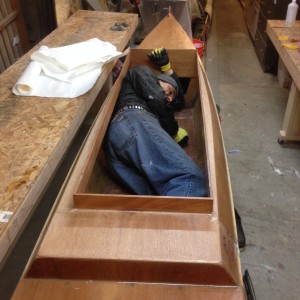For those contemplating a bid in the 2016 (or future?) Race to Alaska, this massive R2AK-2015 spreadsheet that Thomas and I used to plan & track our efforts may be of interest —
One of my favorite parts are the “collaborators” tab which lets you sort through the full race teams in lots of ways. Here’s an extract sorted by progress, including those that finished as well as those that didn’t finish but made some degree of progress to the north of Victoria.
| Place | Time | Last point north | First | Last | Team | Boat type | Boat model |
| days | |||||||
| 1 | 5.0 | Ketchikan | Al | Hughes | Elsie Piddock | Trimaran | F25c |
| 2 | 8.2 | Ketchikan | Wayne | Gorrie | MOB Mentality | Trimaran | 28′ Farrier SR “Mail order bride” |
| 3 | 8.2 | Ketchikan | John | Denny | Por Favor | Monohull | Hobie 33′ |
| 4 | Ketchikan | Trip | Burd | Free Burd | Catamaran | Arc 22 catamaran | |
| 5 | Ketchikan | Matt | Sornson | Kohara | Catamaran | 29′ ? | |
| 6 | Ketchikan | Dan | Blanchard | Un-cruise | Trimaran | F-32 | |
| 7 | 11.6 | Ketchikan | Graham | Henry | Soggy Beavers | OC6 | Advantage Outrigger |
| 8 | Ketchikan | Phil | Wampold | Mau | Catamaran | Nacra 5.7 | |
| 9 | Ketchikan | Al | Lubkowski | Blackfish | Trimaran | F-27 | |
| 10 | Ketchikan | Jeremy | Lucke | Grin | Monohull | Etchell 22 | |
| 11 | Ketchikan | Roger | Mann | Discovery | Trimaran | Hobie Islander | |
| 12 | Ketchikan | Bill | Gifford | Excellent Adventure | Monohull | Montgomery 17′ | |
| 13 | Ketchikan | Patrick | Buntain | Boatyard Boys | Monohull | 17’ Swamspcott Dory | |
| 14 | Ketchikan | Mike | Higgins | Mike’s Kayak | Kayak | 17 foot yellow Prijon Kodiak | |
| 15 | 28? | Ketchikan | Quill | Goldman | Barefoot Wooden Boats | Oar & sail boat | Tad Roberts custom |
| 16 | 14? | Bella Bella | John | Strathman | John | Canoe | 19′ Easyrider w/outrigger |
| 17 | 13.0 | Broughtons | Michael | Dougherty | Puffin | Catamaran | Wharram Tiki 21 |
| 18 | 13.0 | Telegraph Cove | Thomas | Nielsen | Sea Runners | Catamaran | Hitia 17 |
| 19 | Kelsey Bay | Nels | Strandberg | Broderna | Trimaran | F-24(25?) w/ Viking oars | |
| 20 | Otter Bay | Piper | Dunlap | Hexagram 59 | Catamaran | Hobie Miracle 20′ | |
| 21 | N Seymour Narrows | Stephen | Marcoe | Golden Oldies | Catamaran | 38′ Crowther super Shockwave “Nice Pair” | |
| 22 | 9? | S Seymour Narrows | Heather | Drugge | Coastal Express | Monohull | Mirror 16′ |
| 23 | Parksville | Chris | Adams | Super Friends | Monohull | San Juan 21 | |
| 24 | Nanaimo | Phil | Wilmer | Y Triamoto | Trimaran | Multi 23, mini ORMA 60 Van Peteghem Laurent | |
| 25 | Vancouver | George | Corbett | Seawolf | Foiling trimaran | 17′ Seawolf | |
| 26 | Gibbons | Brandon | Davis | Turn Point Design | Catamaran | Turn Point 24 (carbon fiber/nomex) | |
| 27 | Active Pass | Todd | Bryan | Real Thing | Trimaran | L-7 “Firefly” (Multi Marine, Michael Leneman) | |
| 28 | Vancouver | Joe | Bersch | Pure & Wild | Proa | Bieker Proa |
I also like the beach cat comparison tabs, our different food tabs, the many lists, our training logs, and of course our ~2-month build of the main part of the boat (less the rig) —
| Build day | Time Line | Event |
| Tiki Tuesday — 9/23/2014 | Decide to enter race with Scott Veirs | |
| 10/1/2014 | Plans ordered from JWD | |
| 10/1/2014 | Calculated cost of aluminum parts | |
| 10/1/2014 | Emailed Wayne at Down-Home Woods for wood spar quote got a no-quote response | |
| 10/2/2014 | JWD processing plan order | |
| 10/4/2014 | Completed kayak speed test | |
| 10/8/2014 | JWD H17 plans received | |
| 10/11/2014 | Great cabin mocked up | |
| 1 | Tue 10/14 | Build started with the ceremony of the long tables & the death of a flagon of Pyrat (Thanks to our helpers Tim King and Erik Hvalsoe) |
| 2 | Wed 10/15 | T drafts and cuts out bulkheads and hull side panels |
| 3 | Thu 10/16 | T cuts out stem, stern, rudder, lashing backing plates |
| 4 | Fri 10/17 | S cuts out butt blocks; T glues up hull sides with butt blocks |
| 5 | Sun 10/19 | am: Thomas rips stringers, keel; late eve: Thomas staples outer scarfed stringers to hulls; S&T glue scarfed keels |
| 6 | Mon 10/20 | T&S test mirage drive. T maintains 4-5 kph while chatting on phone. Hulls zip tied and stood up with bulkheads in place. |
| 7 | Tue 10/21 | T,S,&K align and glue hull B |
| 8 | Thu 10/23 | T&S align and glue hull A |
| 9 | 10/27/2014 | Keel fillets, End foaming, aft storage locker and diagonals added |
| 10 | 11/1/2014 | Decks made and undersides coated. First spar mock up glued up. |
| 11 | 11/3/2014 | Glued in bunk stringers on hulls and at bulkheads |
| 12 | 11/4/2014 | Glued on cabin sides |
| 13 | 11/5/2014 | Kennewick/paper day |
| 14 | 11/6/2014 | Made bunk cross-stringers, sanded holds |
| 15 | 11/7/2014 | Fitting bunks, painting holds, filling holes and coating bunks. |
| 16 | 11/8/2014 | Glued on decks and fixed bunk boards (with Kevin after Kenmore ride/dip) |
| 17 | 11/9/2014 | Cleaned up fillets, made and fit cabin side stringers and aft coaming pieces |
| 18 | 11/10/2014 | Glued in cabin side stringers and aft coaming pieces; trimmed decks |
| 19 | 11/11/2014 | Make deck and coaming pieces. broke rear seat B loose (do we need glass tape at stress points?) |
| 20 | 11/12/2014 | Coat cabin deck pieces/sand decks/make rudder and handle doublers |
| 21 | 11/13/2014 | Glue up coaming to cabin deck |
| 22 | 11/14/2014 | Fillet underside of coaming. Later glue cabin deck to cabin |
| 23 | 11/15/2014 | Sand decks/cabins, flip to sand hulls, fair stem/stern, shape keel |
| 24 | 11/16/2014 | T&S stay up late to glass cabin ends & rudders |
| 25 | 11/17/2014 | T&S glass decks |
| 26 | Tue 11/18 | T glasses cabin sides during day; T&S sand hulls, glass 1st side of hulls |
| 27 | Wed 11/19 | S fills 1st side hulls and rudder weave w/epoxy coat #2 |
| 28 | Th 11/20 | T & S sand and glass 2nd side of hulls; discuss lash pads & doublers; fill 2nd side rudders |
| 29 | Fri 11/21 | T trims hull glass; S cleans up stringer for fillet, forms doublers & pads |
| 30 | Sat 11/22 | S buys hardware for pads; T&S glue pads, kevlar bow, carbon fiber skeg, fillet stringer, glass keel. |
| 31 | Sun 11/23 | First assembly! |
| 32 | Mon 11/24 | Launch, paddle/mirage drive/flip/right/bail. We got it wet in 42 days (42×6 hours = 252hrs!) |




